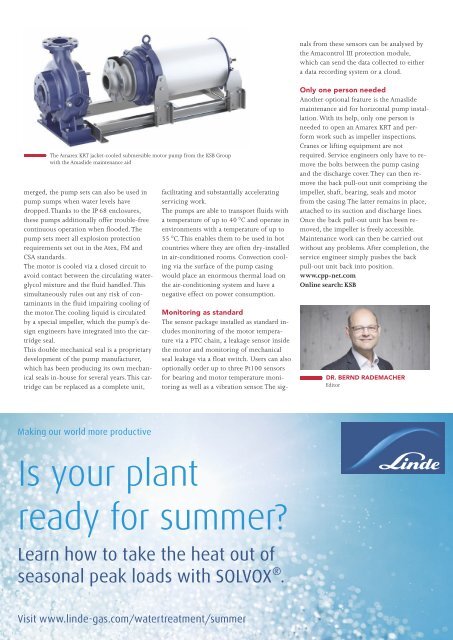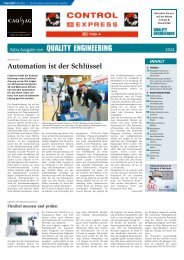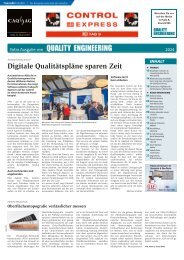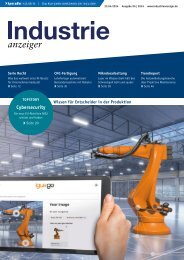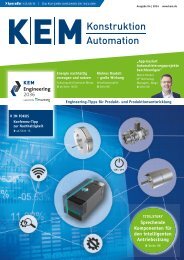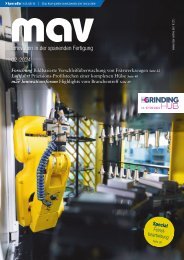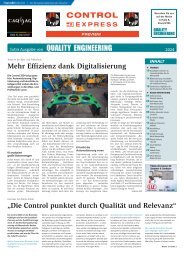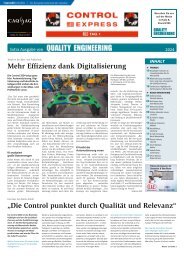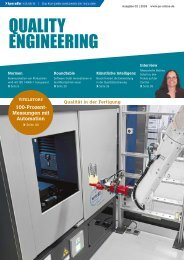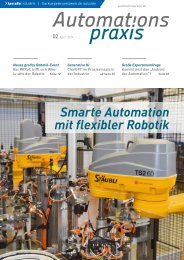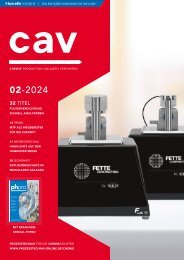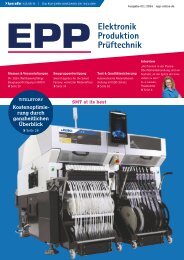cpp – Process technology for the chemical industry 02.2020
The journal cpp - Process technology for the chemical industry reports about processes, plants, apparatus and components for the chemical and pharmaceutical industry. Further topics are IT technologies, industry 4.0, digital production, MSR and automation technology and process analysis technology. The content spectrum is rounded off by explosion protection, plant safety, occupational health and safety, maintenance, site management and energy management.
The journal cpp - Process technology for the chemical industry reports about processes, plants, apparatus and components for the chemical and pharmaceutical industry. Further topics are IT technologies, industry 4.0, digital production, MSR and automation technology and process analysis technology. The content spectrum is rounded off by explosion protection, plant safety, occupational health and safety, maintenance, site management and energy management.
Create successful ePaper yourself
Turn your PDF publications into a flip-book with our unique Google optimized e-Paper software.
nals from <strong>the</strong>se sensors can be analysed by<br />
<strong>the</strong> Amacontrol III protection module,<br />
which can send <strong>the</strong> data collected to ei<strong>the</strong>r<br />
a data recording system or a cloud.<br />
The Amarex KRT jacket-cooled submersible motor pump from <strong>the</strong> KSB Group<br />
with <strong>the</strong> Amaslide maintenance aid<br />
merged, <strong>the</strong> pump sets can also be used in<br />
pump sumps when water levels have<br />
dropped. Thanks to <strong>the</strong> IP 68 enclosures,<br />
<strong>the</strong>se pumps additionally offer trouble-free<br />
continuous operation when flooded. The<br />
pump sets meet all explosion protection<br />
requirements set out in <strong>the</strong> Atex, FM and<br />
CSA standards.<br />
The motor is cooled via a closed circuit to<br />
avoid contact between <strong>the</strong> circulating waterglycol<br />
mixture and <strong>the</strong> fluid handled. This<br />
simultaneously rules out any risk of contaminants<br />
in <strong>the</strong> fluid impairing cooling of<br />
<strong>the</strong> motor. The cooling liquid is circulated<br />
by a special impeller, which <strong>the</strong> pump’s design<br />
engineers have integrated into <strong>the</strong> cartridge<br />
seal.<br />
This double mechanical seal is a proprietary<br />
development of <strong>the</strong> pump manufacturer,<br />
which has been producing its own mechanical<br />
seals in-house <strong>for</strong> several years. This cartridge<br />
can be replaced as a complete unit,<br />
facilitating and substantially accelerating<br />
servicing work.<br />
The pumps are able to transport fluids with<br />
a temperature of up to 40 °C and operate in<br />
environments with a temperature of up to<br />
55 °C. This enables <strong>the</strong>m to be used in hot<br />
countries where <strong>the</strong>y are often dry-installed<br />
in air-conditioned rooms. Convection cooling<br />
via <strong>the</strong> surface of <strong>the</strong> pump casing<br />
would place an enormous <strong>the</strong>rmal load on<br />
<strong>the</strong> air-conditioning system and have a<br />
negative effect on power consumption.<br />
Monitoring as standard<br />
The sensor package installed as standard includes<br />
monitoring of <strong>the</strong> motor temperature<br />
via a PTC chain, a leakage sensor inside<br />
<strong>the</strong> motor and monitoring of mechanical<br />
seal leakage via a float switch. Users can also<br />
optionally order up to three Pt100 sensors<br />
<strong>for</strong> bearing and motor temperature monitoring<br />
as well as a vibration sensor. The sig-<br />
Only one person needed<br />
Ano<strong>the</strong>r optional feature is <strong>the</strong> Amaslide<br />
maintenance aid <strong>for</strong> horizontal pump installation.<br />
With its help, only one person is<br />
needed to open an Amarex KRT and per<strong>for</strong>m<br />
work such as impeller inspections.<br />
Cranes or lifting equipment are not<br />
required. Service engineers only have to remove<br />
<strong>the</strong> bolts between <strong>the</strong> pump casing<br />
and <strong>the</strong> discharge cover. They can <strong>the</strong>n remove<br />
<strong>the</strong> back pull-out unit comprising <strong>the</strong><br />
impeller, shaft, bearing, seals and motor<br />
from <strong>the</strong> casing. The latter remains in place,<br />
attached to its suction and discharge lines.<br />
Once <strong>the</strong> back pull-out unit has been removed,<br />
<strong>the</strong> impeller is freely accessible.<br />
Maintenance work can <strong>the</strong>n be carried out<br />
without any problems. After completion, <strong>the</strong><br />
service engineer simply pushes <strong>the</strong> back<br />
pull-out unit back into position.<br />
www.<strong>cpp</strong>-net.com<br />
Online search: KSB<br />
DR. BERND RADEMACHER<br />
Editor<br />
<br />
<br />
<br />
<br />
<br />
<br />
<strong>cpp</strong> 02-2020 27


